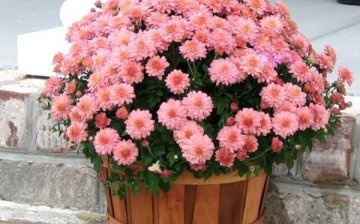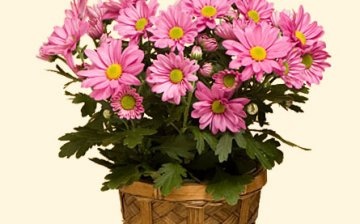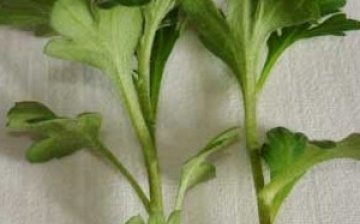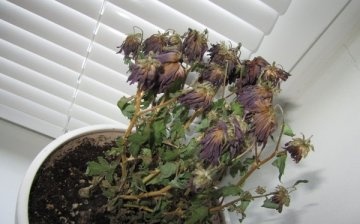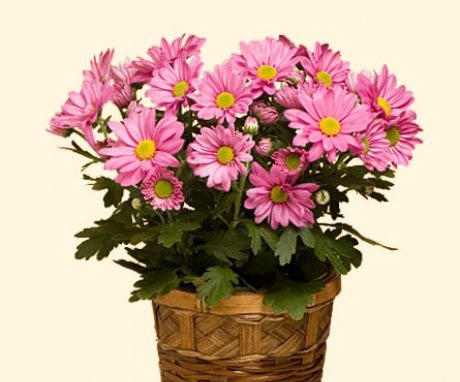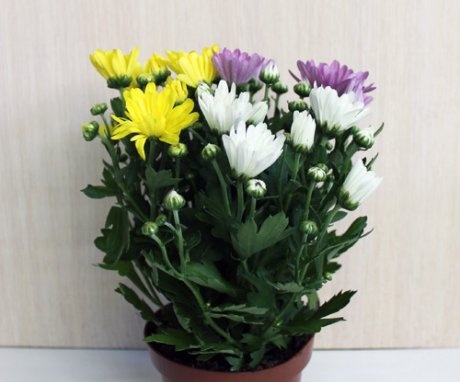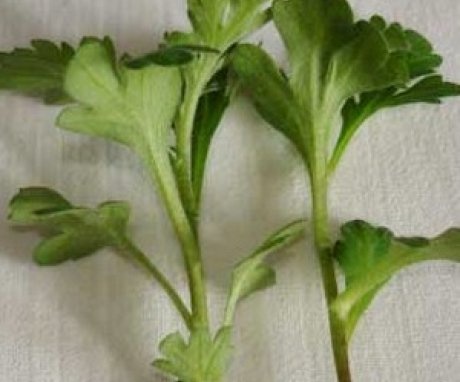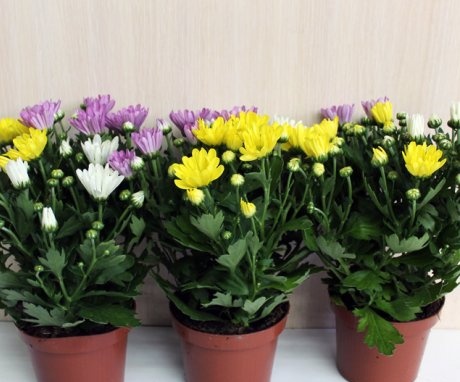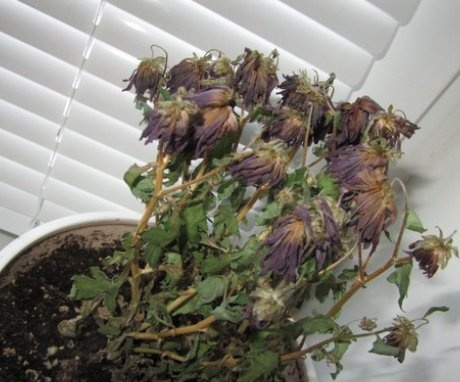Caring for home chrysanthemums - watering, feeding and transplanting flowers
Chrysanthemum - a flower known to everyone. It is a very popular plant. Many garden flowers can be grown at home, such as a rose. Chrysanthemum can also be grown indoors. Indoor plant varieties come in many varieties. Indeed, quite recently it seemed that such a flower could fully develop only in the garden, but it was precisely because of the appearance of plant varieties that the flower moved to a warm home windowsill.
Content:
- Conditions for growing domestic chrysanthemums
- Proper care of home chrysanthemums
- How to transplant and propagate a plant?
- How to feed chrysanthemum?
- Diseases and pests of flowers
Conditions for growing domestic chrysanthemums
Indoor varieties chrysanthemums were bred artificially. Beautiful appearance and small size are regulated by special stimulants. The plant will strive to return to its original, genetically laid down, appearance, therefore, it is necessary to know some rules for caring for the plant so that it pleases with abundant flowering.
Usually, only two types of chrysanthemums are grown in pots - shrub and Chinese.
Placing the flower in a cool room with fresh air is perhaps the basic rule to keep in mind when growing. The temperature in the room should not exceed 18 degrees, and the plant should not be exposed to direct sunlight. The best temperature is from 10-14 degrees. Sluggish leaves are a clear signal that the plant is too hot.
For a lush and attractive flowering of chrysanthemums, you need to create suitable conditions... Gardeners tend to believe that this plant is unpretentious, and therefore. look after you do not need to be especially diligent after her. But it doesn't. It is very important to adhere to the rules in the care of this delicate flower.
You should definitely pay attention to such conditions as:
- Lighting
- Air humidity
- Watering
- Soil composition
Proper care of home chrysanthemums
Never place the pot in direct sunlight. The plant does not like excessive lighting. A light window sill would be an excellent option, but in the heat, the plant needs to create an artificial shade.
This plant does not require constant spraying from a spray bottle, but if you carry out a similar procedure at least sometimes, it will have a good effect on the appearance of the flower. You need to spray either early in the morning or in the evening. Make sure that there is no dust on the leaves of the flower.
Watering flowers:
- For home chrysanthemums, increased watering is very important, but the soil should not be constantly damp.
- During the growth of the flower, you need to make sure that the ground is constantly slightly damp.
- The plant during this period needs to be watered two or even three times a week.
Mix the correct soil before planting, this will make it much easier to care for the flower later. Mix two parts turf with one part humus and one part sand. Remember that the plant does not like acidic soil very much.
How to transplant and propagate a plant?
Until chrysanthemum young, it needs to be replanted every year, increasing the volume of the container.An adult plant is transplanted every couple of years. The composition of the soil should not change. Add some bird droppings to the soil for a lush bloom. Care must be taken that the earth is not acidic. If this happens, the plant will not only grow terribly, but it may not bloom at all. Disease prevention can be carried out by watering the soil with boiling water and drying it.
Some gardeners think that chrysanthemum is an annual and therefore throw it away after a year. Not at all. The plant can be preserved and even propagated.
There are no difficulties in leaving for the chrysanthemum after flowering. To do this, cut off the stems, and transfer the container to a dark and cool room. If the indoor chrysanthemum gave new shoots at the time of pruning, then they are not needed prune... You can place a container with chrysanthemum in the basement, you should not stop watering. The plant will overwinter, and in the spring you can start propagating this beautiful flower.
There are two ways by which you can breed a vending chrysanthemum - this is the division of the bush, or grafting.
The first method is better, as it is more reliable and guarantees the success of the event. It is necessary to start reproduction during the intensive growth of young shoots. One bush of home chrysanthemum can give up to six new shoots. Prepare planting pots in advance, fill them with soil. Carefully separate the roots of the new shoot, plant it in a pot and water it heavily. If done correctly, the plant can bloom in the first year after breeding.
Cutting home chrysanthemums:
- Must be cut from the bush cuttings about ten centimeters long.
- Treat them with root or heteroauxin and plant them in a prepared container.
- Deepen the cuttings one and a half centimeters, cover the container with foil.
- Hold seedlings in a warm room, the temperature in the room should not be less than eighteen degrees.
- Sometimes plant pots need to be ventilated to avoid fungal diseases.
- After the chrysanthemum grows fifteen centimeters, the top should be pinched so that the bush forms correctly.
How to feed chrysanthemum?
Just planting a flower in high-quality soil and watering it from time to time is not enough. Any plant will very quickly select all nutrients from the ground, which is why the room chrysanthemum needs periodic feeding.
Mineral fertilizers will have a beneficial effect on the health of the flower.
If you do not feed the plant with potassium or phosphorus on time, it will bloom ahead of time. To avoid such a nuisance, the plant needs to be fed with potassium monophosphate or make up fertilizer based on potassium, phosphorus and nitrogen (2: 3: 1).
An adult flower needs to be fed every ten days, when the increased growth of leaves and shoots begins. Liquid organics are ideal. It is worth feeding the chrysanthemum until the buds are formed.
Diseases and pests of flowers
Diseases and pests the house chrysanthemum was very fond of. Especially often this plant is affected by the spider mite. If you see a whitish cobweb on the plant, then urgent measures are needed. It is tedious to wipe the leaves and stems of the plant with a sponge soaked in soapy water, then the bush should be rinsed under warm water. A solution of pyrethrum or actellic will also help get rid of this pest.
The most common disease that affects this particular plant is powdery mildew:
- A grayish bloom forms on the leaves and peduncles.
- The disease is fungal. It occurs due to high humidity.
- Treat the plant with a fungicide and take it out to a dry place.
Often, flower growers notice an ashy, like a fluffy bloom on a beautiful flower. This disease is called "gray rot". It multiplies, which causes the edges of the leaf to turn brown. chrysanthemums, brownish spots appear on them. Spray the flower with foundation, place the container with the plant in a sunny, constantly ventilated place.
Excessive dryness is also not good, as the chrysanthemum can be infected by the red spider mite.
The main sign will be the appearance of brown spots with a yellow edging on the leaves of the plant. In order to get rid of the pest, you need to reduce watering and treat the plant with foundation. The reason for the lack of flowering can be a lack of fertilizer or improper organization of the light regime. The plant needs both a bright place and a short daylight hours. If the flower buds begin to fall off, increase the humidity in the room, spray the plant more often. Examine the plant carefully. It is possible that he was struck by some kind of disease or pest.
More information can be found in the video.



